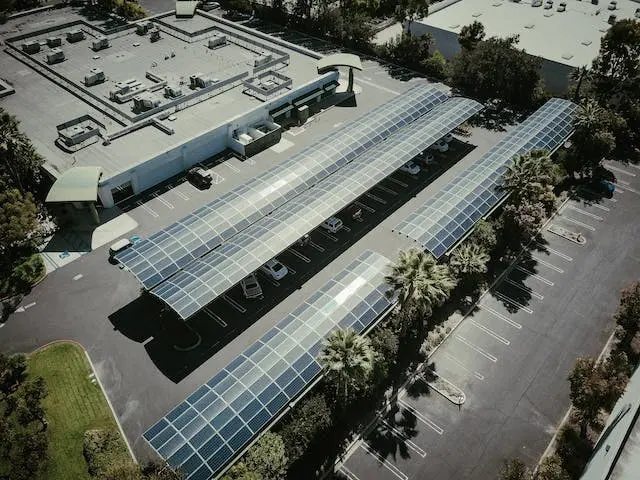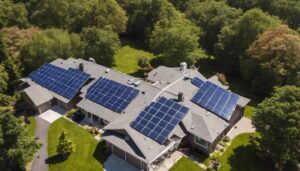Imagine you’ve invested in a state-of-the-art solar panel system, expecting it to cut your electric bills significantly. However, without the right tactics for optimizing its performance, you might not be seeing the returns you anticipated.
You’ve got the high-efficiency panels, but to truly maximize your energy generation, there’s more to consider than just the hardware. Proper panel orientation and tilt, strategic shading prevention, and regular maintenance play pivotal roles in the amount of power your system can produce. And let’s not forget about the technological advancements in inverters and monitoring systems that can further enhance efficiency.
As you seek to unlock the full potential of your solar investment, understanding and implementing these strategies becomes essential. So, how can you ensure your solar panels are operating at their peak, and what might you be overlooking that could transform your solar output? Let’s explore the tactics that could elevate your solar game to the next level.
Key Takeaways
- Establish a regular cleaning schedule and use efficiency analytics to determine the optimal cleaning frequency for solar panels.
- Proper panel positioning, including aiming for a true south orientation and adjusting the tilt angle based on latitude and season, is crucial for maximizing sun exposure and energy production.
- Preventing shading from trees, buildings, or other objects is important for maintaining panel performance and efficiency.
- Implementing a solar energy monitoring system, conducting regular checks, and utilizing trend analysis and energy management software can help track production, identify patterns or issues, and schedule maintenance for optimal performance.

Regular Panel Cleaning
To keep your solar panels operating at peak efficiency, it’s essential to establish a routine cleaning schedule. Dirt, dust, and other residues can accumulate on your panels, hindering their ability to absorb sunlight. By regularly removing this grime, you’ll ensure that you’re getting the most out of your solar investment.
Efficiency analytics can be incredibly helpful in determining the optimal cleaning frequency for your panels. These tools analyze performance data to pinpoint when energy output starts to decline, which is often due to soiling. By tracking this trend, you’ll know exactly when it’s time to clean, rather than sticking to an arbitrary schedule.
Weather impacts also play a significant role in solar panel cleanliness. If you live in an area with frequent rain, nature might take care of some of the cleaning for you. However, in arid or dusty regions, you’ll likely need to clean your panels more often. It’s also worth noting that after particularly severe weather, such as a dust storm or heavy snowfall, you should check and clean your panels to restore their function quickly.

Optimal Panel Positioning
While ensuring your solar panels are clean is crucial, positioning them for maximum sun exposure is just as important for optimal energy production. You’ve got to place those panels so they’re basking in the sun’s rays as much as possible, every single day.
Here’s how to position your solar panels effectively:
Orientation and Tilt
- For those in the northern hemisphere, aim for a true south orientation.
- Adjust the tilt angle according to your latitude for the best year-round performance.
- Remember, the angle can be tweaked seasonally for even better results.
- In summer, a lower tilt captures more sunlight.
- In winter, increase the tilt to catch the low-hanging sun.
Avoiding Shade
- Keep an eye out for potential new obstructions, like growing trees or new constructions.
- Regularly evaluate the surroundings to maintain clear sun exposure.
Advanced Positioning
- Consider sun tracking systems if your budget allows.
- These systems adjust the panels throughout the day to follow the sun’s path.
- Tilt adjustments can be manual or automated, with the latter providing ease and increased efficiency.

Shading Prevention Measures
Ensuring your solar panels remain free from shade is a key step in safeguarding their energy output and efficiency. Even a small amount of shading can significantly decrease the performance of your entire panel setup. To combat this, keep an eye out for any potential shade-makers like trees or protruding parts of nearby buildings. Regular tree trimming is essential to prevent branches from casting shadows during the sun’s peak hours. It’s not just about the immediate vicinity—sometimes, even distant foliage can cause partial shading during certain times of the day.
But what if you can’t remove the object causing the shade? That’s where innovative solutions come in. The use of reflective coatings on surrounding surfaces can help redirect sunlight onto your panels. This clever tactic can squeeze out every bit of sunlight, especially in constrained spaces.
Performance Monitoring Routines
Establishing a routine for monitoring your solar panels’ performance is crucial for maximizing their energy output and longevity. By staying on top of solar panel maintenance and engaging in regular data analysis, you’ll ensure that your investment continues to pay off both in the short and long term.
Here’s how you can keep tabs on your system:
Set up a solar energy monitoring system to track production and usage patterns.
- Daily Checks: Observe real-time energy production and consumption.
- Alerts: Set up notifications for sudden changes in performance.
- Trend Analysis: Use historical data to identify patterns or issues.
Use energy management software to identify and address any efficiency drops.
- Diagnostic Tools: Pinpoint specific components that may need attention.
- Performance Metrics: Track the efficiency of your panels over time.
- Maintenance Scheduling: Plan routine cleanings and inspections based on data.
Regularly monitor system performance to detect any issues or underperformance.
- Visual Inspections: Check for physical damage or soiling that can impact output.
- Energy Audits: Evaluate system performance against expected benchmarks.
- Upgrade Opportunities: Consider enhancements like a solar power concentrator or backup battery.

Inverter and Equipment Upgrades
Have you considered how an inverter upgrade could significantly boost your solar panel system’s efficiency? Upgrading to a higher-efficiency inverter not only maximizes energy production but also ensures that you’re getting the most out of your system’s output. With the heart of your solar setup being the inverter, it’s crucial to have one that matches the latest technology in terms of inverter efficiency.
Advanced monitoring systems are another game-changer. These systems allow you to track your system’s performance in real time, giving you insights into how well your solar panels are working and where improvements can be made. It’s not just about producing energy; it’s about doing it smartly and efficiently.
Here’s a quick comparison to show you the impact of these upgrades:
|
Standard Equipment
|
Upgraded Equipment
|
|---|---|
|
Basic inverter
|
High-efficiency inverter
|
|
Limited monitoring
|
Advanced monitoring systems
|
|
Fixed functionality
|
Smart inverter capabilities
|
Investing in equipment upgrades isn’t just a short-term fix; it’s about ensuring long-term efficiency and effectiveness. Optimizing your inverter design and capacity leads to better energy conversion, and when you couple that with advanced systems, you ensure peak performance for years to come.
Facts About The Tactics for Peak Solar Panel Performance In Australia
- 🦎 Australia’s unique wildlife contributes to solar panel inefficiency as bird droppings and dust from local creatures can accumulate on panels, reducing their performance.
- 🌦️ Contrary to popular belief, solar panels can still generate energy on cloudy days in Australia. The diffuse sunlight can penetrate through the clouds, albeit at a lower intensity.
- 🌬️ Strategic panel tilting can optimize performance in windy regions. Adjusting panel angles to minimize wind resistance helps prevent damage and enhances overall efficiency.
- ☔ Rainfall may be beneficial for solar panels in arid regions like Australia. A light rain shower can naturally clean the panels, removing accumulated dirt and dust, thereby improving their output.
- 🏡 Homeowners often overlook the impact of shading on overall system performance. Even small amounts of shading from nearby trees or structures can significantly reduce a solar panel’s efficiency.
- 🔄 Periodic cleaning is essential, but high-pressure water should be avoided. Gentle cleaning methods, such as using a soft brush or sponge, are more effective in maintaining long-term performance.
- 🌐 Remote monitoring and maintenance technologies are becoming more accessible. Implementing these systems allows for real-time tracking of individual panel performance, aiding in early detection of issues.
- 🌅 Morning and evening sunlight can be harnessed more efficiently with east-west orientation of solar panels. This configuration ensures a more balanced energy production throughout the day.
- 📏 Proper spacing between solar panels is crucial to prevent heat buildup. Adequate ventilation reduces the risk of hot spots and enhances the overall longevity of the panels.
- 🔄 Regular firmware updates for inverters can unlock additional features and performance improvements. Staying informed about the latest updates can maximize the efficiency of the entire solar power system.
Frequently Asked Questions
How Do You Maximize the Efficiency of a Solar Panel?
To maximize your solar panel’s efficiency, adjust its orientation to face south, and make seasonal adjustments to the tilt angle for optimal sunlight capture. Keep it free of shade and debris for the best performance.
How Can I Maximize My Solar Usage?
To maximize your solar usage, adjust your solar orientation to the sun’s path and consider the weather’s impact. You’ll capture more energy, cutting costs and boosting your system’s overall efficiency.
How Do I Get the Most Power From My Solar Panels?
To get the most power from your solar panels, you’ll want to focus on optimal panel orientation and make seasonal adjustments to the tilting angle, ensuring maximum sunlight exposure year-round.
What Is Good Peak Efficiency for Solar Panels?
You’ll find good peak efficiency for solar panels around 15-20%. Higher rates, above 22%, are excellent but consider panel degradation and climate impact on performance when choosing your system for long-term efficiency.
Conclusion
In the pursuit of maximizing your solar panel performance, remember these key tactics: prioritize regular cleaning to remove grime and optimize efficiency, position panels strategically for optimal sun exposure, prevent shading to maintain peak performance, establish a routine monitoring system, and consider equipment upgrades for long-term efficiency gains.
By implementing these strategies, you’ll harness solar power more efficiently, leading to increased energy production and savings. Now, put these tactics to work and let the sun power your sustainable future.



